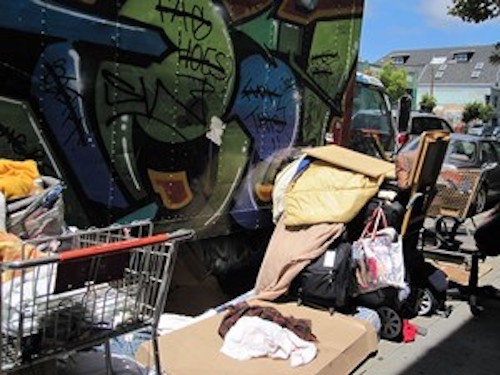
With the population on the streets aging, homelessness mimics a chronic disease
Homeless encampment, Oakland, Calif. (Photograph courtesy of Kelly Ray Knight, PhD)
Homelessness is like other chronic medical problems: in need of a cure. That realization came to Margot Kushel as she was working as a resident physician at San Francisco General Hospital in the 1990s, and it has shaped her work ever since. More than a third of the patients in the inpatient wards were homeless, seeking medical care for issues that were often exacerbated by life on the streets. The patients rotating in and out of the hospital faced complex health problems. They had just one thing on their side: youth.
Kushel, now professor of medicine at the University of California San Francisco, recalled that homelessness in the 1990s was a problem of young adults, and “youth is the single best defense against illness.” No longer. Today the people sleeping in shelters, under overpasses and on park benches look more like your grandfather than your younger brother.
People over 50 are the fastest-growing segment of the homeless population, and they are battling more chronic physical and mental conditions than homeless people in previous generation—from hypertension and cancer to depression and post-traumatic stress disorder (PTSD). Many of these adults were born in the tail end of the baby boom; they came of age during the Vietnam War, entered the job market during the recession of the 1970s and lived through the crack cocaine epidemic and the associated harsh sentencing for drug crimes. Kushel cites these as some of the reasons why the median age of the U.S. homeless population has steadily increased in recent years. This disturbing trend is the focus of new research she presented on October 11, at CASW’s New Horizons in Science briefings, part of the ScienceWriters2015 conference in Cambridge, Massachusetts.
Figuring out a cure for homelessness requires measuring its causes and consequences. Kushel and her team went to shelters, encampments, food lines, and recycling centers around Oakland, Calif. to recruit 350 homeless adults over 50 for their current study. The researchers had in-depth conversations with the study participants, some lasting as long as three hours, about their health, family background and current circumstances. AS the study continues, they follow up with participants every month and sit down for detailed check-ins every six months. Each participant has a unique story, but as Kushel and her team have begun to crunch the numbers, some common and startling experiences have emerged.
Declining health and homelessness: a vicious cycle
“From the moment of homelessness, health begins to plummet,” Kushel said.
Nearly half of the participants in Kushel’s study became newly homeless after age 50. Most have family contacts and social ties in the community. Many are men and women who worked consistently in low- or semi-skilled jobs until their jobs disappeared in a changing economy, or until illness or the wear of physical labor on their bodies made working impossible. Others are chronically homeless, victims of abuse or in and out of the criminal justice system. Their backgrounds are varied, but the common experience of living on the streets has health consequences no matter where they came from.
Adapting to common experiences of aging is something most people take for granted, but Kushel says managing the challenges of aging can be nearly impossible when you’re homeless. Someone who has trouble balancing might install a grab bar or shower chair in the home home—not a solution for someone unsure where her next shower will be. Navigating the web of social services available to the homeless is challenging under the best of circumstances. For one in four adults in Kushel’s study, that challenge is aggravated by severe cognitive impairments.
“The rates of impairment are surprising considering that people are living on the streets. It’s almost hard to believe that people are able to survive under those environments when they are doing so poorly,” Kushel said.
Layered on these physical and mental difficulties are chronic conditions that require careful medical management: hypertension, diabetes, depression. Taking medication regularly takes a back seat to the search for food and shelter. While the stereotype of someone on the streets is someone who ended up there because of severe mental health problems, for many people the relationship between health and homelessness is cyclical. Mental health conditions like depression or PTSD certainly make it difficult to work.
“It’s equally clear to me that when people lose their housing, these problems get so much worse,” said Kushel.
Hope in re-housing and re-engaging
Re-housing people is the first step in breaking this cycle, but Kushel emphasizes that it is important to find ways that people can contribute to society. In an interview, she recalled one particularly memorable patient, relatively well-educated but facing family challenges and some major health crises that left him living in his car. He was on edge and depressed, and together he and Kushel struggled to control his medical problems. But he got into permanent housing, got his medical problems under control, and started teaching art.
“He is someone who has a lot to offer, a tremendous artist and teacher and is really adding a lot to his community environment,” said Kushel. “And all of that was kind of left on the table when he was living alone in his car. He didn’t have any of that to offer anyone. And I think of all of these people’s lives who have been touched by him now that we’ve been able to solve this problem and how much left he’s had to contribute that we were overlooking.”
Curing a chronic condition has never come easy, and homelessness is no exception. At the one-year check-in for Kushel’s study, some participants have homes in rental housing, with family, or in nursing facilities, and their health is improving. Though more than half of them remain homeless, there is hope.